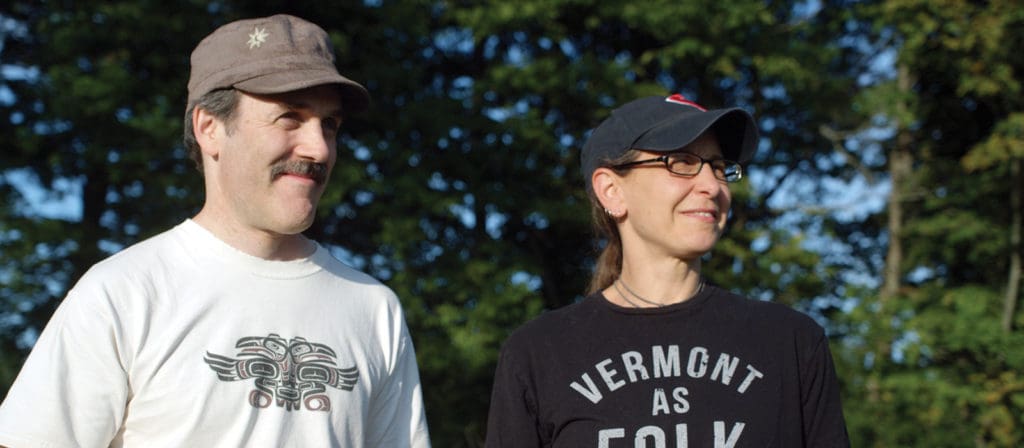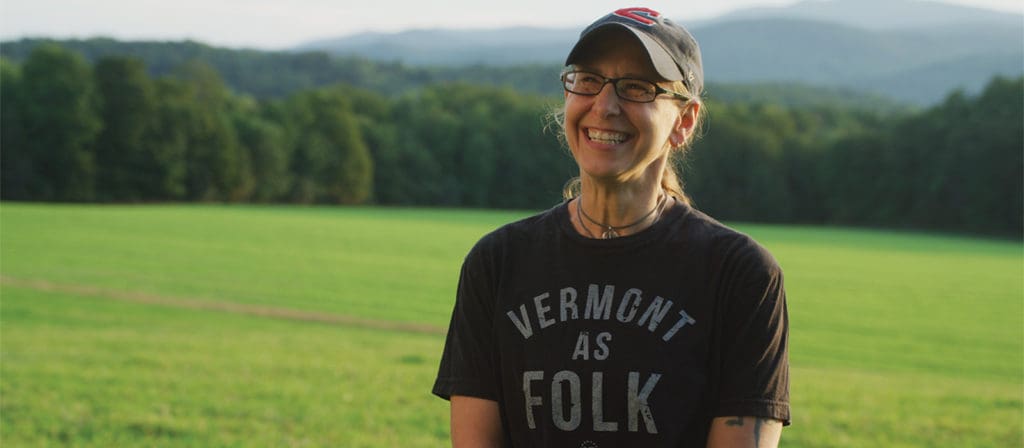Vermont’s I-89 boasts many beautiful views along its 191 miles, but one of its most scenic vistas lies at Exit 4 in Randolph. As you leave the highway, the road opens to reveal nearly 200 acres of lush farm fields sloping down to a valley of dense trees, with mountains cascading to the horizon.
It’s an iconic Vermont image, one that inspired Milo Cutler to make her home here more than 20 years ago. “I saw this gorgeous view and the whales’ tails,” she recalls, referring to a granite sculpture of two 13-foot-tall whale tails rising out of the grass in the valley, “and I’ve been here ever since.”
Having grown up in a small town in Ohio, Cutler appreciated the way of life in a rural community. But she had seen her hometown change drastically during her childhood. “It grew and grew, with strip mall after strip mall,” she says. “There’s no community anymore. It’s really Anywhere, U.S.A.”
So when word got around in 2015 that a developer planned to pave over that iconic vista to build a hotel, a conference center, housing, and an industrial park, she and other residents were concerned. “To pave over 170 acres with industry – I saw it happen in Ohio, and it destroyed the town.”
There was no question that Randolph, with its historic downtown, could use an economic boost. But the 1.15-million-square-foot development was out of scale for the small village of barely 4,800 people. “Having a hotel at an interstate exit with minimum wage jobs is not what’s going to make a town prosper,” she says. And the 250 homes proposed? “There were well over 100 houses on the market in Randolph, so that was not anything that the town needed, either.”
What’s more, Randolph is located in one of Vermont’s most rural counties, and its agricultural soils are rated as some of the highest quality in the state. With farmland under increasing pressure from development, farmers in the community were understandably worried about losing prime acreage.

One night soon after learning about the proposal, about 20 residents, Cutler among them, gathered in a local living room to talk about what they could do to fight it. “We didn’t know if we could stop this development or not,” says David Hurwitz, who, with Cutler, became a spokesperson for the group. “But we did know that as citizens of this community, we wanted to have our voices heard.”
At first, the group wasn’t taken seriously, as the development proposal already had the zoning permits and other town-level approvals it needed. “A lot of town officials and others brushed us off and said it’s too late to do anything,” recalls Hurwitz. But the proposal faced one last hurdle: a state-level Act 250 hearing.
Act 250 is a law unique to Vermont that helps prevent sprawl and addresses environmental issues with potential developments. To receive a permit, a proposal must meet ten criteria, including its impact on agricultural soils.
The neighbors decided to intervene in the Act 250 hearing, organizing officially as Exit 4 Open Space to give them the status they needed for a seat at the table.
Meanwhile, CLF Senior Attorney Sandy Levine had been watching the development proposal progress from her office a half hour away in Montpelier. Levine has been tracking sprawl and the loss of farmland in Vermont for years, working to counter the statewide trend and strengthen the laws that protect these valuable lands. “Good farmland is in increasingly short supply,” she says. “Vermont’s thriving farm economy, our healthy environment, and our healthy climate all depend on it.”
When CLF and its partners at the Vermont Natural Resources Council (VNRC) saw the Randolph developer’s Act 250 application, they planned to get involved in the proceedings to prevent the proposal from moving forward.
Levine attended an Exit 4 Open Space meeting ahead of the state hearings and knew she’d found the right allies. “They were encouraged that there were professional lawyers and planners stepping in,” she says. “We were excited that there was a core of enthusiastic local citizens raring to go.”
Act 250 proceedings can be difficult for citizens to navigate without a lawyer or legal background of their own. What’s more, bringing in experts to testify on residents’ behalf gets expensive. “Sandy helped us tremendously in terms of how we could get involved, what we could do, and how we could present things to the commission overseeing the process,” says Hurwitz.
Over the course of several hearings – with months in between each one – CLF, VNRC, and the residents made their case. Then, just as all the parties were preparing a summary of comments for final review by the Act 250 Commission, the developer put the plans on hold. He later withdrew the original sprawling proposal, sold all but 22 acres of the land to a farmer, and agreed to sell the remaining acres if $1 million could be raised in 60 days.
Raising that amount of money in barely two months would be daunting anywhere, but “to do that in a small rural community was a huge challenge,” says Hurwitz. But Exit 4 Open Space, CLF, and VNRC, as well as Preservation Trust of Vermont, rose to the challenge, raising the massive sum in 57 days. More than $200,000 came from Randolph residents themselves. “Randolph is not a high-income town, but that much money coming out of this community shows the level of support and how much people wanted this land to be preserved,” says Hurwitz.

Now a walking path and an orchard will be planted on those 22 acres, while the remaining land is permanently protected and in the hands of a local farmer supplying milk for Vermont Creamery.
When Cutler, Hurwitz, and their neighbors first got involved in this fight, no one expected it to take up two to three years of their lives. “But to have the outcome we had, it was definitely worth it,” says Cutler.
Hurwitz agrees. “It was a long haul and a lot of focus to make this happen, especially for the people in our group who were juggling this with our own careers,” he says. “So it feels great standing here knowing we were able to come this far.”
“It was a remarkable accomplishment on many levels,” reflects Levine. “It really empowered the community and shows what a small group of committed citizens can achieve.”
